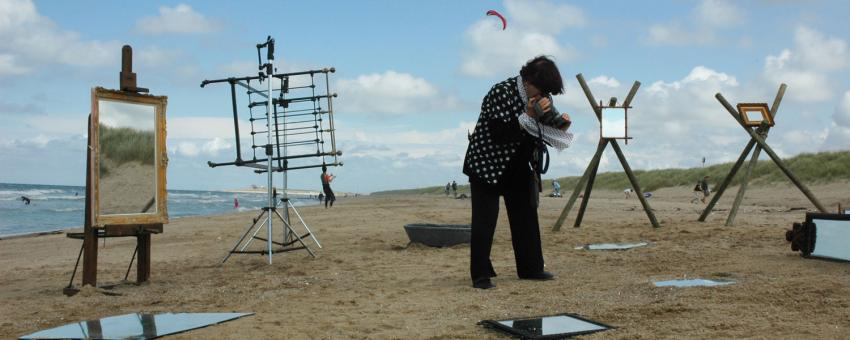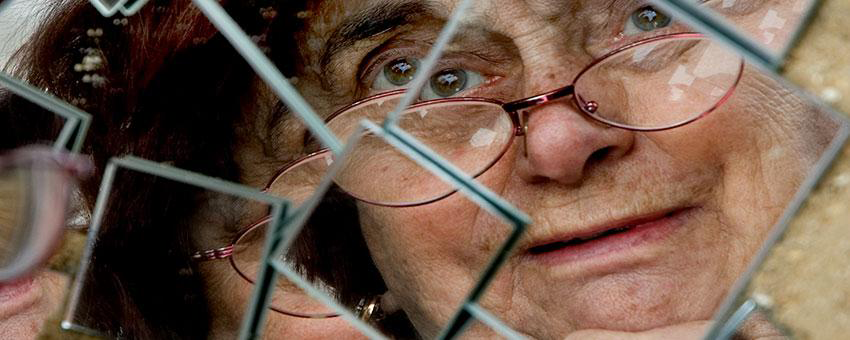On October 8, a very short woman dressed in red velour enters the café at the Logan Center for the Arts accompanied by a small entourage, speaking French to a tall, spiky-haired woman next to her. No one else in the café freaks out. I run out to the curb to catch a friend of mine and tell her the amazing news: Agnès Varda is in Café Logan eating a salad.
Varda herself is an unassuming figure, so it’s hard to be too angry with Logan’s other, unfazed patrons. She is very short and dresses in very comfortable, swooshy jewel tones. Were it not for her distinctive haircut—the same bowl-cut she’s had since the forties, dyed red and white—she’d be easily confused with any other aged continental patron of the arts. But Varda is that and something more. Now, she’s at the University of Chicago for a retrospective that encompasses her sixty-five-year working history as a photographer, director, and installation artist.
Not many people saw her first film, La Pointe Courte, when it debuted in 1955, but some of those who did, then merely young movie buffs, became some of the most influential directors ever. Because it presaged the titanic shocks the film world would experience five years later, the movie earned Varda the vaguely patronizing title “Grandmother of the French New Wave,” and Varda and two close friends soon became the biggest lights of a movement called “Left Bank” cinema. In 1961, working with a producer who liked New Wave directors because they worked cheap, Varda made Cléo from 5 to 7, an international hit that would vault her into the top echelon of directors.
A fantastic selection of her films from the last sixty years was on display at the Logan Center, with two other essentials shown elsewhere. The Music Box Theatre in Wrigleyville was offered their pick and chose the epochal Cléo, and Black Cinema House hosted Varda’s 2000 documentary The Gleaners and I.
UofC Cinema and Media Studies lecturer Dominique Bluher, who has been working to program the festival for two years, says that Black Cinema House was a natural choice for a screening. Varda had a “wonderful” meeting with Theaster Gates, who renovated the theater, and toured the Stony Island Arts Bank. Bluher calls the pairing of Gleaners and BCH “obvious.” Gleaners is about people who scavenge for food and belongings that the rest of society leaves behind, who exist on the margins, who must create things out of whatever they find. The film has thematic resonance with the reclaimed and renovated space that houses BCH, as well as with Gates’s project of recycling crumbling South Side artifacts into arts spaces.

At the Logan Center, festivities kicked off October 8 with the Chicago premiere of a television series Varda made in 2011 about her travels around the world, Agnès Varda: From Here to There. The next day, there was a reception in the gallery displaying her photography and installation works. The keynote installation features ten pounds of potatoes spread out at the feet of a triptych of screens displaying slideshows of potatoes. It’s called Patatutopia.
The next day screenings get going in earnest, divided into four thematically related blocks, with 1985’s Vagabond as an untethered treat on Saturday night. One may notice as they watch Varda’s films, if they pay attention, that nearly all of them are about women, their relationships with each other, and their interior lives. You’d be forgiven for not noticing, though, because Varda is never pushy or didactic about her feminism. She says during a Q&A that One Sings, the Other Doesn’t, which addresses the fight for legal abortion, is a musical because “whenever you start talking about feminism people start yawning. I didn’t want to bore these people.” This by no means implies that the feminist underpinnings of her work are less deeply felt or conveyed. She has made some of the most sensitive, nuanced films about women in the history of cinema, and she does it so consistently you’d never know that the history of film is as male-dominated as it is.
The timeless relevance of feminist film is one explanation for Varda’s appeal and for the relevance of her residency at the UofC, but it’s not necessarily the best one. At the gallery reception on October 9, the crowd has diverse reasons for attending. But the most common one is simple: Varda herself.
People love Agnès. They love her hair, her obsessions with potatoes and cats, the ineffable earnestness in everything she does. There’s a perception that she’s earned everything she has, doubly so because she’s one of the few women to have reached such heights. But part of her aura is her legend and status as a remnant of a different era in the history of the movies.
Consider: most of her New Wave and Left Bank compatriots are dead, and most of the non-French directors that defined that period—the peak of American cinephilia—are gone now too. Truffaut, Bergman, Kurosawa, Fellini and a dozen others have all passed on, many in the last couple decades. Seeing Agnès Varda speak about her films and share gossip from the old days is a way of defying the transition of the midcentury movie scene from memory to history.
Varda, though, would push back against her apotheosization. At a master class with the UofC Cinema and Media Studies majors working on creative BA theses, Varda shows a sharper side. Presented with three projects that look at the past, histories of never-met family members and disappearing UNESCO world heritage sites, the director is puzzled. “You are so much into the past, you don’t want to take a look at people living now?” she asks pointedly. She wonders why they think they’ll learn more about themselves by looking at things found in storage or museums.
In this light it’s easier to see the organizing principle that made the residency program such a wonderful summation of not only Varda’s work, but her philosophy. Bluher, who has been Varda’s friend for the past fifteen years, succeeded in separating Varda’s astounding film and photographic work from their historical freight, letting them speak as the striking artistic statements that they are. Shunting Cléo off to Wrigleyville kept the lesser seen works here on the South Side, and gave South Side residents the real advantage in understanding Varda, instead of only understanding the French New Wave. Encompassing yet focused retrospectives like this one allow Agnès Varda to continue to be, in Bluher’s words, “inspiring to every generation.”

